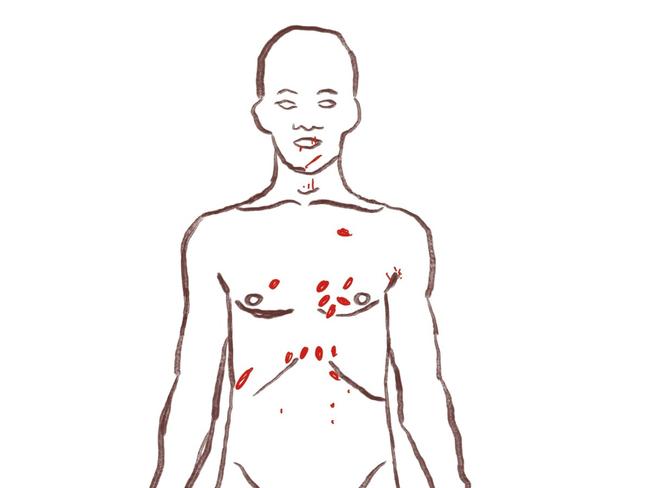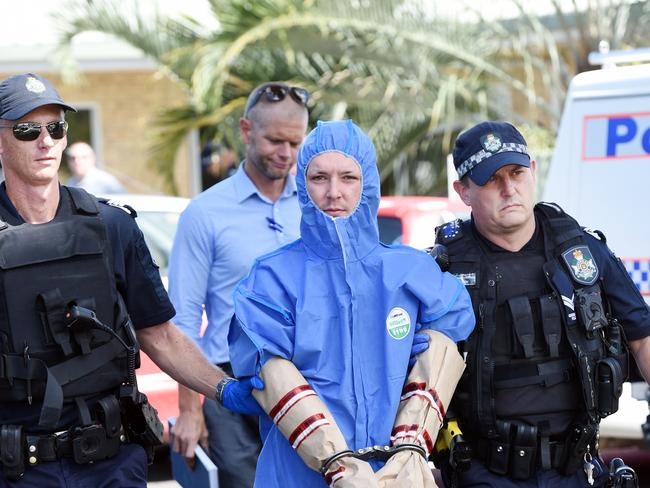Jake Ashman murder trial: Darren Ints autopsy evidence
Confronting photos have been shown in a murder trial as the pathologist who carried out the autopsy says a slain Queensland father’s heart kept beating even after being punctured four times by a knife. *Distressing content
Police & Courts
Don't miss out on the headlines from Police & Courts. Followed categories will be added to My News.
Darren Ints’s heart continued beating for some time after four of 34 stab wounds pierced his heart, a pathologist has told a murder trial.
The confronting evidence was offered in Rockhampton Supreme Court where the Maryborough father’s former neighbour, Jake Scott Ashman, 25, has pleaded not guilty to killing him at the Granville unit complex where they had both lived.
Queensland Health specialist forensic pathologist Dr Christopher Day explained the results of the autopsy he carried out on Mr Ints in 2019, outlining his findings of each of the 34 stab wounds, along with blunt force injuries.

The court hears Mr Ints was 183cm and weighed 97kg at the time of his death.
Dr Day said when he examined the body he found four knife inflicted wounds on his face – one on his upper lip, two on his lower lip that could have come from one strike, and a fourth on his chin.
Photographs of the wounds were shown to the court as Dr Day explained his observations.
Mr Ints had three small wounds over his oesophagus, the biggest being 1.2cm long and going 2cm deep, cutting through cartilage and muscle of the Adam’s apple.
Mr Day said a cluster of five stab wounds close together in the heart region crisscrossed under the skin - forming a common wound path.

“Four wounds have penetrated the pericardial sac, which is the lining over the heart and four separate injuries have entered the heart itself,” he said.
“Of those four, one injury has entered the right chamber of the heart to go through the right ventricle which is one of the large chambers of the heart, and terminated within the aorta.
“Two further injuries have entered the left chamber of the heart where they have terminated.”
Dr Day said the fourth’s path went in front of the heart but has not penetrated the chest cavity.
The court heard the aorta was not severed and the maximum depth of those wounds was 7.5cm.
The length of the blade of a yellow handled knife located by police was said to be 15.2cm and the blade of a black handled knife, 11.5cm.
Dr Day said one of the wounds in that cluster would have required severe force as it cut through a rib bone.
He said most of the others would have required a moderate force.
He also recalled “a great deal of internal bleeding associated with the injuries to the chest wall in the cavity surrounding the heart”.
“There was 200mm of blood surrounding the heart itself within the pericardium … and because that had been breached by the injuries, there was cumulation within the left chest cavity – there was a litre of blood within that left chest cavity as well,” he said.

“So significant amount of internal bleeding.
“There is evidence that once the heart has been penetrated, there has been ongoing pumping of the heart. “So there has been life following penetration with the heart and that’s evidenced by the amount of blood that’s collected around the heard within the cavity, as well as within the left chest cavity.
“There would have been a decrease in the level of consciousness certainly and then I can’t say certainly whether unconsciousness would have occurred prior to cardiac arrest or whether they’ve occurred simultaneously.”
Dr Day said generally, it was possible a person could physically move following such injuries.
He said Mr Ints had a severe degree of coronary atherosclerosis at the time of his death, a small amount of the active ingredient in marijuana and therapeutic levels antipsychotic medication in his system – none contributing to his death.
Justice Peter Davis asked Dr Day if death was imminent after the heart wounds were sustained.
“Without immediate surgical intervention, yes”, Dr Day responded.
The court also heard evidence from a Queensland Police Service forensic scientist about the blood evidence located throughout both Mr Ints and Mr Ashman’s units and their shared bathroom.
Queensland Police Service forensic scientist Karoline Berndt was questioned in court on Wednesday about the blood trail throughout the two units where the two men had shared a bathroom.
“I was requested to attend after a blood shedding incident,” Ms Berndt said about the day of alleged stabbing

She said she found blood stains outside Mr Ints’ front door on the concrete, then some on the tiles in the doorway, blood on the front door and inside the door around the doorknob.
Photographs of the blood were shown in court.
She said once inside, there was a blood smear on the corner of the kitchen bench right near the front door and on a blue-checkered towel further along the bench.
On a single seat armchair, which had been moved by emergency services earlier in the day, Ms Berndt said she found “a fine blood spatter stain across the entire area” on the side of the chair where the foot rest handle was located.
The blood trail continued on the floor, walls and doorways past where Mr Ints’s body was found, into his bedroom, into the shared bathroom and into the accused’s unit, she said
Inside the bathroom, blood spatters were found on the wall next to the toilet, on the wall below the height of the hand basin near the entry way, on the floor, the toilet bowl and shower door.
The court also heard Mr Ints’s glasses were located adjacent to the drain pipe running from the hand basin with the chain that was usually attached to them found in the area near the shower door and toilet.
Ms Berndt claimed there was evidence of an attempted blood clean up due to “the appearance of diluted blood” running from the top of the door to the handle on the lock side of the sliding door between Mr Ashman’s bedroom and his kitchen/lounge area.
She said there was a blood stain on the table in Mr Ashman’s living area and there were blood stains on the front face of the drawers of the bench.
Ms Berndt said Mr Ashman’s kitchen taps, while not visibly having blood on them, did test positive for blood.
A towel under Mr Ashman’s bed also had a blood stain on it, she said.
The trial continues.




